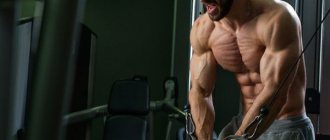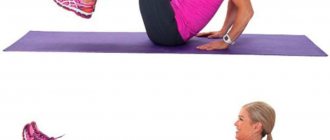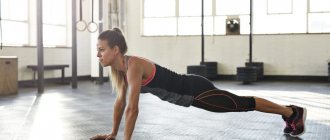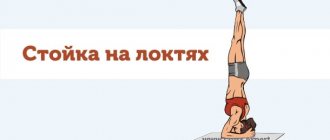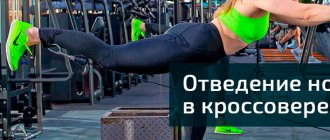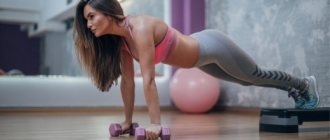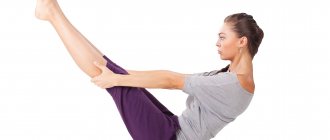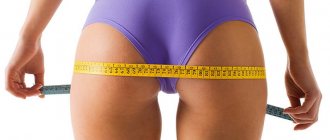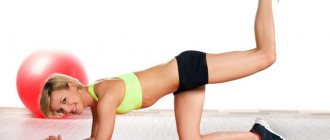The lumbar spine could not exist on its own. To move, bear the load and protect the spine and nerve structures, stability is needed, the conditions for which are created by muscles and internal organs. Stability is ensured through the coordinated work of the active (muscles), passive (lumbar spine) and controlling (nervous system) components. The term "core stability" is a subject of frequent debate and there is a lot of confusion around it. Traditionally, this term refers to the active component of the stabilization system, including deep (local) muscles that provide stability to individual segments (for example, the transverse abdominis and multifidus lumbar muscles), and/or superficial (global) muscles (rectus abdominis, erector spine), which provide movement of the torso and also help maintain balance in more difficult conditions. The authors suggest a variety of core stabilization exercises, ranging from navel retractions to sit-ups and planks.
Deep muscle training (invented by physical therapists) is a fairly complex skill that requires meticulous work and a lot of guidance, very strict evaluation by the trainer and constant feedback. Training the superficial muscles is an equally complex task, on which a number of medical and sports specialists work using a variety of techniques. An alternative to the term “core stability” is “motor control,” which reflects a more global approach to the concept of lumbar stability. This approach takes into account issues related to the functioning of the central nervous system, afferentation, motor and adaptive reactions.
Exercises on the horizontal bar
Circular Leg Raise
Make sure the bar is high enough so that your feet don't touch the floor while hanging. Grab the bar with both hands at shoulder width. Tighten your abdominal muscles and raise your legs at a right angle. Then start drawing circles clockwise with both feet. Keep your abdominal muscles tense at all times. Perform 8-10 repetitions and then repeat in the opposite direction. Repeat 8-10 times on each side.
Simplified version: Try doing the exercise on the wall bars, this will make it easier to maintain balance.
Bicycle hanging
Grasp the bar with your hands shoulder-width apart. Raise your legs at a 90-degree angle parallel to the floor. Instead of bringing your knees together, lift them up one at a time, as if you were riding an imaginary bicycle. Perform the exercise at maximum speed for 30 seconds.
Hanging lateral crunches
Hang on the bar, tighten your abdominal muscles. Bend your knees at a right angle. Slowly bend your knees to the side, trying to raise your feet as high as possible. Then slowly return to the starting position. Repeat on the other side. Perform 8-10 repetitions.
Detection of muscle dysfunction
Deep muscles
Assessing deep muscle function is essentially the same as performing treatment. In this matter, it is very important to understand how navel retraction (pretension of the transverse abdominis muscle), isometric activation of the multifidus muscle, diaphragmatic breathing and activation of the MTD are normally performed. In addition to clinical diagnostic methods, ultrasound can be used.
Superficial muscles
A wide range of tests are available to identify superficial muscle dysfunction in the context of core stabilization/motor control. Specific tests include the following:
- Instability test in the prone position.
- Test for maintaining the torso in an extension position while lying on the stomach (paraspinal endurance limit according to Biering-Sorenson).
- Quadratus lumborum muscle endurance test (lateral bridge retention test).
- Bridge lying on your back.
- Lying on your back leg lowering test (lower abdominal endurance).
- Torso twisting while lying on your back.
- External rotation of the hip.
- Modified Trendelenburg test (one-leg squat with control in the frontal plane).
- Squat on one leg in the sagittal plane.
- Squat on one leg in the transverse plane.
These deep and superficial muscle tests should be performed and interpreted using principles of clinical reasoning, with a good understanding of normal and abnormal motor control. Preliminary data have now been obtained for a clinical prediction rule targeting people with back pain. According to these data, patients who meet the following criteria are more likely to respond to specific motor control exercises/specific deep muscle activation:
- Age under 40 years.
- Greater overall flexibility (the patient's ability to straighten the leg from a lying position to 90 degrees).
- Postpartum period.
- Positive test for instability in the supine position.
- The presence of abnormal movements in the spine (painful movements, abnormal lumbopelvic rhythm, the need to hold hands for support).
Exercises on the block
Isometric lateral row
Don't be intimidated by this exercise, it's easier than it looks. Start with a light weight and pull the block up to chest level. Stand next to the machine on the left side. Grasp the handle with both hands and take one large step away from the machine. Pull the block into the handle, keeping your hands at chest level. Brace your core and keep the block upright. Focus on proper technique and don't lean forward. Hold for 30 seconds and then perform the exercise on the other side.
Side bends from the lower block
Select a medium weight and prepare a block. Stand with your back to the machine, holding the handle with your right hand. Bend your left arm and place it behind your head. Pull your abdominal muscles in and lean to the left of the machine. Return to the starting position and repeat the bends 10-15 times. Then change sides .
Side plank and lower block row
Select a light weight, lie facing a low block, and assume a side plank position, resting on your forearm. Grab the handle with an overhand grip with your free hand. The arm should be fully straightened. Tighten your abdominal muscles and move your elbows back, pulling the handle toward you. Hold the position for 30 seconds . Slowly return your hand to the starting position.
Seated overhead pull-down
Select a light weight and grab the lower block. Get into a lunge position close to the machine. Grasp the handle with both hands and raise your arms above your head. The goal of this exercise is to engage your core muscles. Don't lean forward. Hold for 30 seconds and stand with your left side facing the crossover. Repeat the exercise for another 30 seconds.
Functions of the core muscles
Most often, the core muscles act as stabilizers and a center for transmitting force, rather than as a source of movement.
Many people train these muscles with isolated exercises, such as abdominal or back exercises. They do crunches or sit-ups instead of functional exercises like deadlifts, squats, push-ups, and a variety of other closed kinetic chain exercises.
Closed kinetic chain (or closed chain) exercises are performed with a rigidly fixed body segment. For example, when you do push-ups, your arms and feet are rigidly fixed: they stand on the floor and do not move.
By training with isolation exercises, you not only miss the basic function of your core muscles, but you also miss out on the opportunity to develop strength and gain better control of your movements.
Developed core muscles make it possible to control the force we use. According to the work Assessment Of core stability: developing practical models. researcher Andy Waldhem, there are five different components of core stability: strength, endurance, flexibility, movement control and functionality.
Without movement control and functionality, the other three components are useless: a fish that is pulled out of the water will not be able to do anything, no matter how strong and resilient it is.
By maintaining core stability during any activity, be it running, snatching weights, or lifting heavy weights at home, you reduce the risk of injuring your back.
Barefoot exercises
Climber
Place the bosu flat side up. Start by doing a push-up at the top of a flat platform with your hands under your shoulders and your feet behind you. Keeping your arms in place and your body in line (plank position), bring one knee toward your chest and then lower it down to meet the other. Quickly alternate with the other side and continue alternating. Repeat for 30 seconds.
Simplified version: Pull your knees up to chest level only, not your elbows.
Bosu pleat
Place the bosu flat side down. Lie on your bare feet with your legs straight and your arms stretched behind your head. Try not to bend your lower back, but keep it as close to the floor as possible. Lift your shoulder blades and legs off the floor at the same time, keeping them straight. The fulcrum should be the upper part of the buttocks. Stretch your arms forward and try to fold yourself so that your toes touch your toes, hold for 30 seconds . Then return to the starting position and repeat.
Side crunches on barefoot
Place the bosu flat side down. Lie sideways on the ball. Place your hands behind your head, legs straight. Then begin twisting upward so that your elbow moves towards your hip. Do 10-12 reps, then switch sides.
Side crunches on barefoot
Place the bosu flat side down. Lie sideways on the ball. Place your hands behind your head, legs straight. Then begin twisting upward so that your elbow moves towards your hip. Do 10-12 reps, then switch sides.
Additional recommendations
The question of how to pump up core muscles is of secondary importance for many people starting training. The problem of losing weight comes to the fore. And here not only regular physical activity is important, but also a balanced diet. After all, without the necessary vitamin, mineral and amino acid replenishment, the same muscles, and the ligamentous-articular apparatus, will suffer. Not to mention the state of internal organs and general well-being. To help those who want to lose weight according to all the rules and not gain it back, the natural Kilo Light .
These are three drugs with different compositions, but subordinated to a single goal - to make the weight loss process as comfortable and effective as possible. This is achieved in the following ways:
- normalization of metabolic processes by improving the functioning of the thyroid gland;
- increasing overall tone and replenishing the body’s energy needs throughout the day;
- stimulation of natural fat burning mechanisms;
- suppression of the deceptive feeling of hunger that haunts even after eating;
- removing toxins from the body;
- prevention of a number of disorders caused by weakness of connective tissue against the background of rapid weight loss: varicose veins, cellulite, etc.;
- increasing the body’s resistance to stress so that extra pounds do not return;
- improving blood supply and delivery of nutrients to tissues and organs;
- improving sleep and activating fat burning processes while you sleep.
Lose weight confidently and without nerves with Kilght Light !
You can purchase this complex in pharmacies, as well as specialized online stores.
Exercises with a roller
Oblique rolling
If you've never used a roller, now is the time to change that. Try this exercise. Get on your knees and grab the handles of the machine. Make a roll to the side. First go left, go back and do the exercise to the right. Repeat 10-12 times on each side.
Exercises with TRX
Pull-up turns
Hang the TRX at waist height. Face the TRX with your feet slightly wider than hip-width apart. Grasp the handles with both hands and bring them together. Take a few steps back from the TRX so your arms are extended. Brace your core and reach into a vertical position, moving your arms to the right. Return to the starting position and repeat, but this time turn your arms to the left. Perform 10-12 repetitions on each side.
Simplified version : Stand further away from the TRX, this will allow you to be at a lower angle and make the exercise easier to perform.
Climber with a turn
Adjust the TRX straps so they are at knee height. Kneel with your back to the TRX. Place both feet in the TRX handles and move into a plank position. Shift your weight to your hands. Bring your knees together and try to pull them towards your right elbow. Return to the starting position. Repeat the exercise on the other side. Repeat 10-12 times.
Simplified version : Bring your knees toward your chest one at a time.
Pica exercise
Start in the same position as in the previous exercise. Tighten your abdominal muscles, keep your legs straight and move into a high plank position (legs should be in loops). As you exhale, use your abdominal muscles to lift your pelvis up, keeping your legs straight. Slowly return to plank position with straight arms and do 10-12 repetitions.
Clinical anatomy
Deep (local) muscles
The deep muscles originate from the lumbar vertebrae and for this reason provide a stabilizing and strengthening effect to the area.
The mechanism of deep muscle function, as well as the maintenance of stability/stability, is a rather controversial issue, but it can be assumed that the transverse abdominis muscle, together with the diaphragm and pelvic floor muscles (PFM), can act as a kind of container. Co-contraction of these muscles increases intra-abdominal pressure and, hypothetically, increases stability due to connections with the thoracolumbar fascia. The multifidus muscles increase the rotational stability of the lumbar spine segments in the sagittal and horizontal planes.
The normal functioning of the deep muscles is disrupted due to back pain. There is compelling evidence that specific training in motor control and specific muscle activation is effective in restoring this function.
Superficial (global) muscles
There are a number of large superficial muscles that cross several different segments of the human body, but do not directly attach to the spine. These include the rectus abdominis, external obliques, and some parts of the erector spinae muscles. These muscles act as “tension cables” that control the position of the spine. They also work together to control the movement of the spine when it experiences external stress.
Barbell exercises
These exercises are suitable for experienced athletes. If you are a beginner, use a barbell without weights to perform these exercises.
Lying leg raise
Lie on the mat, grab a barbell, hands at shoulder width. Stretch your arms with the barbell up. Tighten your core and keep your legs straight. Lift your legs up to the right side, keeping your back on the mat. Slowly lower your legs back and repeat to the left. Do 10-12 repetitions on both sides.
Simplified version : Practice proper technique without a barbell.
Barbell crunches
In addition to the barbell, you will also need an incline bench. Lie down on the bench and hold your feet firmly. Grab a barbell with your hands shoulder-width apart. Press the dumbbell upward while keeping your arms fully extended. Essentially, this exercise is similar to crunches, only with a barbell overhead. Keep your back straight. Return slowly to the starting position and repeat the exercise 8-10 times with heavy weight . If you choose a light weight, do 10-12 repetitions.
Simplified version : Try doing incline crunches without a barbell. Feel each muscle and stick to the correct technique.
FIRST LAP
- Walking in plank
: 15 reps
2. Push-ups
: 15 reps
Possible from the knees:
3. Twisting
: 20 reps
4. Bicycle
: 15 reps on each side
5. Shoulder Touch in Plank
: 15 reps on each side
6. Hyperextension with arms out
: 15 reps
7. Swimmer
: 15 reps on each side
8. Side plank
: 15 reps on each side
9. Leg abduction in reverse plank
: 15 reps on each side
10. Scissors
: 20 reps on each side
11. Bridge
: 25 reps
